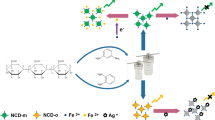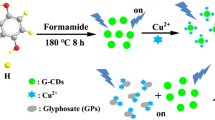Abstract
Carbon dot (CD)-based fluorescent probes have been widely exploited; however, multi-component detection using CDs without tedious surface modification is always a challenging task. Here, we develop a convenient and simple CD-based “on-off-on” fluorescent probe for detection of copper(II) ion (Cu2+), ascorbic acid (AA), and acid phosphatase (ACP). Cu2+ leads to the fluorescence quenching of CDs. The limit of detection (LOD) for Cu2+ is 2.4 μM. When AA is added into the CDs + Cu2+ solution, Cu2+ is reduced by AA to Cu+, causing the fluorescence recovery of CDs. The fluorescent intensity linearly correlates with the concentration of AA in the range of 100–2800 μM with LOD of 60 μM. Besides, the probe has potential application for detection of AA in real samples such as VC tablets, orange juice, and fresh orange. The probe can also indirectly detect ACP that enzymatically hydrolyzes ascorbic acid-phosphate (AAP) to produce AA. This work expands the application of CDs in the multi-component detection and provides a facile fluorescent probe for detection of AA in real samples.

Graphical abstract








Similar content being viewed by others
References
Xu XY, Ray R, Gu YL, Ploehn HJ, Gearheart L, Raker K, et al. Electrophoretic analysis and purification of fluorescent single-walled carbon nanotube fragments. J Am Chem Soc. 2004;126(40):12736–7.
Dong YQ, Cai JH, You X, Chi YW. Sensing applications of luminescent carbon based dots. Analyst. 2015;140(22):7468–86.
Wang YF, Hu AG. Carbon quantum dots: synthesis, properties and applications. J Mater Chem C. 2014;2(34):6921–39.
Sun XC, Lei Y. Fluorescent carbon dots and their sensing applications. Trends Anal Chem. 2017;89:163–80.
Yan FY, Jiang YX, Sun XD, Bai ZJ, Zhang Y, Zhou XG. Surface modification and chemical functionalization of carbon dots: a review. Microchim Acta. 2018;185(9):424.
Zheng M, Xie ZG, Qu D, Li D, Du P, Jing XB, et al. On off on fluorescent carbon dot nanosensor for recognition of chromium(VI) and ascorbic acid based on the inner filter effect. ACS Appl Mater Interfaces. 2013;5(24):13242–7.
Basu A, Suryawanshi A, Kumawat B, Dandia A, Guin D, Ogale SB. Starch (tapioca) to carbon dots: an efficient green approach to an on-off-on photoluminescence probe for fluoride ion sensing. Analyst. 2015;140(6):1837–41.
Han CP, Wang R, Wang KY, Xu HT, Sui MR, Li JJ, et al. Highly fluorescent carbon dots as selective and sensitive “on-off-on” probes for iron(III) ion and apoferritin detection and imaging in living cells. Biosens Bioelectron. 2016;83:229–36.
Zhao FJ, Qian JL, Quan FF, Wu CX, Zheng Y, Zhou L. Aconitic acid derived carbon dots as recyclable “on-off-on” fluorescent nanoprobes for sensitive detection of mercury(II) ions, cysteine and cellular imaging. RSC Adv. 2017;7(70):44178–85.
Lqbal A, Lqbal K, Xu LG, Li B, Gong DY, Liu XY, et al. Heterogeneous synthesis of nitrogen-doped carbon dots prepared via anhydrous citric acid and melamine for selective and sensitive turn on-off-on detection of Hg (II), glutathione and its cellular imaging. Sensors Actuators B Chem. 2018;255:1130–8.
Gao G, Jiang YW, Jia HR, Yang JJ, Wu FG. On-off-on fluorescent nanosensor for Fe3+ detection and cancer/normal cell differentiation via silicon-doped carbon quantum dots. Carbon. 2018;134:232–43.
Gao XX, Zhou X, Ma YF, Qian T, Wang CP, Chu FX. Facile and cost-effective preparation of carbon quantum dots for Fe3+ ion and ascorbic acid detection in living cells based on the “on-off-on” fluorescence principle. Appl Surf Sci. 2019;469:911–6.
Gaggelli E, Kozlowski H, Valensin D, Valensin G. Copper homeostasis and neurodegenerative disorders (Alzheimer’s, prion, and Parkinson’s diseases and amyotrophic lateral sclerosis). Chem Rev. 2006;106(6):1995–2044.
Sivaraman G, Iniya M, Anand T, Kotla NG, Sunnapu O, Singaravadivel S, et al. Chemically diverse small molecule fluorescent chemosensors for copper ion. Coord Chem Rev. 2018;357:50–104.
Guo YM, Zhang LF, Zhang SS, Yang Y, Chen XH, Zhang MC. Fluorescent carbon nanoparticles for the fluorescent detection of metal ions. Biosens Bioelectron. 2015;63:61–71.
Purbia R, Paria S. A simple turn on fluorescent sensor for the selective detection of thiamine using coconut water derived luminescent carbon dots. Biosens Bioelectron. 2016;79:467–75.
Yang R, Guo XF, Jia LH, Zhang Y. A fluorescent “on-off-on” assay for selective recognition of Cu(II) and glutathione based on modified carbon nanodots, and its application to cellular imaging. Microchim Acta. 2017;184(4):1143–50.
Chen J, Li Y, Lv K, Zhong WB, Wang H, Wu Z, et al. Cyclam-functionalized carbon dots sensor for sensitive and selective detection of copper(II) ion and sulfide anion in aqueous media and its imaging in live cells. Sensors Actuators B Chem. 2016;224:298–306.
Haldon E, Nicasio MC, Perez PJ. Copper-catalysed azide-alkyne cycloadditions (CuAAC): an update. Org Biomol Chem. 2015;13(37):9528–50.
Achadu OJ, Revaprasadu N. Tannic acid-derivatized graphitic carbon nitride quantum dots as an "on-off-on" fluorescent nanoprobe for ascorbic acid via copper(II) mediation. Microchim Acta. 2019;186(2):87.
Qian ZS, Chai LJ, Tang C, Huang YY, Chen JR, Feng H. A fluorometric assay for acetylcholinesterase activity and inhibitor screening with carbon quantum dots. Sensors Actuators B Chem. 2016;222:879–86.
Qu ZY, Li N, Na WD, Su XG. A novel fluorescence “turn off - on” nanosensor for sensitivity detection acid phosphatase and inhibitor based on glutathione-functionalized graphene quantum dots. Talanta. 2019;192:61–8.
Luo XL, Zhang WG, Han Y, Chen XM, Zhu L, Tang WZ et al. N,S co-doped carbon dots based fluorescent “on-off-on” sensor for determination of ascorbic acid in common fruits. Food Chem 2018;258:214–221.
Qian ZS, Chai LJ, Huang YY, Tang C, Shen JJ, Chen JR, et al. A real-time fluorescent assay for the detection of alkaline phosphatase activity based on carbon quantum dots. Biosens Bioelectron. 2015;68:675–80.
Qian ZS, Chai LJ, Tang C, Huang YY, Chen JR, Feng H. Carbon quantum dots-based recyclable real-time fluorescence assay for alkaline phosphatase with adenosine triphosphate as substrate. Anal Chem. 2015;87(5):2966–73.
Qian ZS, Chai LJ, Zhou Q, Huang YY, Tang C, Chen JR, et al. Reversible fluorescent nanoswitch based on carbon quantum dots nanoassembly for real-time acid phosphatase activity monitoring. Anal Chem. 2015;87(14):7332–9.
Liu C, Tang B, Zhang S, Zhou MM, Yang ML, Liu YF, et al. Photoinduced electron transfer mediated by coordination between carboxyl on carbon nanodots and Cu2+ quenching photoluminescence. J Phys Chem C. 2018;122(6):3662–8.
Praneerad J, Thongsai N, Supchocksoonthorn P, Kladsomboon S, Paoprasert P. Multipurpose sensing applications of biocompatible radish-derived carbon dots as Cu2+ and acetic acid vapor sensors. Spectroc Acta Pt A-Molec Biomolec Spectr. 2019;211:59–70.
Li LB, Wang C, Luo JX, Guo QW, Liu KY, Liu K, et al. Fe3+-functionalized carbon quantum dots: a facile preparation strategy and detection for ascorbic acid in rat brain microdialysates. Talanta. 2015;144:1301–7.
Fong JFY, Chin SF, Ng SM. A unique “turn-on” fluorescence signalling strategy for highly specific detection of ascorbic acid using carbon dots as sensing probe. Biosens Bioelectron. 2016;85:844–52.
Shamsipur M, Molaei K, Molaabasi F, Alipour M, Alizadeh N, Hosseinkhani S, et al. Facile preparation and characterization of new green emitting carbon dots for sensitive and selective off/on detection of Fe3+ ion and ascorbic acid in water and urine samples and intracellular imaging in living cells. Talanta. 2018;183:122–30.
Huang YY, Zhou J, Feng H, Zheng JT, Ma HM, Liu WD, et al. A dual-channel fluorescent chemosensor for discriminative detection of glutathione based on functionalized carbon quantum dots. Biosens Bioelectron. 2016;86:748–55.
Guo Y, Yang LL, Li WW, Wang XF, Shang YH, Li BX. Carbon dots doped with nitrogen and sulfur and loaded with copper(II) as a “turn-on” fluorescent probe for cystein, glutathione and homocysteine. Microchim Acta. 2016;183(4):1409–16.
Liao S, Huang XQ, Yang H, Chen XQ. Nitrogen-doped carbon quantum dots as a fluorescent probe to detect copper ions, glutathione, and intracellular pH. Anal Bioanal Chem. 2018;410(29):7701–10.
Sun S, Jiang K, Qian SH, Wang YH, Lin HW. Applying carbon dots-metal ions ensembles as a multichannel fluorescent sensor array: detection and discrimination of phosphate anions. Anal Chem. 2017;89(10):5542–8.
Funding
This work was financially supported by the National Natural Science Foundation of China (Nos. 21603196 and 51703209) and the Fundamental Research Funds for the Central Universities, China University of Geosciences (Wuhan) (Nos. CUGL170406 and CUG170601).
Author information
Authors and Affiliations
Corresponding authors
Ethics declarations
Competing interests
The authors declare that they have no competing interests.
Additional information
Publisher’s note
Springer Nature remains neutral with regard to jurisdictional claims in published maps and institutional affiliations.
Electronic supplementary material
ESM 1
(PDF 109 kb)
Rights and permissions
About this article
Cite this article
Ma, X., Lin, S., Dang, Y. et al. Carbon dots as an “on-off-on” fluorescent probe for detection of Cu(II) ion, ascorbic acid, and acid phosphatase. Anal Bioanal Chem 411, 6645–6653 (2019). https://doi.org/10.1007/s00216-019-02038-z
Received:
Revised:
Accepted:
Published:
Issue Date:
DOI: https://doi.org/10.1007/s00216-019-02038-z




